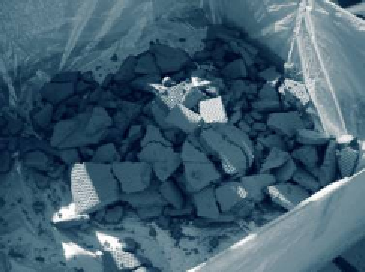Environmental Engineering Reference
In-Depth Information
The liquid fraction of tailings or 'tailings liquor' may in some cases contain dissolved
substances which pose a potential risk to receiving waters and downstream aquatic ecosys-
tems. In such cases decant water, runoff and seepage from tailings impoundments can be
collected and treated prior to discharge or reuse.
The main alternatives in the design of surface tailings storage facilities involve:
1. Layout of retention structures, inl uenced mainly by site topography;
2. The retention structure itself, usually involving one or more Earth or Earth and rock
embankments (concrete dams have also been used), the design of which depends
mainly on the properties of materials available locally;
3. The discharge arrangement, which may involve single or multiple spigot discharge
points, at i xed or movable locations, and
4. Water recovery or decant systems, which are generally selected to meet operating
requirements.
Dry Stacking
Dry stacking of tailings is perhaps the most promising development in recent years as it
broadens the options for tailings disposal schemes. Dry stacking involves i ltration of the
tailings slurry to remove most of the liquid, producing a 'i lter cake' that is unsaturated -
typically with a moisture content of 35% or less (
Figure 18.7
). Belt or vacuum i lters may
be used to accomplish the dewatering. The i lter cake is not pumpable, and requires trans-
portation by truck or conveyor system to the ultimate deposition area.
The advantages of dry-stacked tailings are:
1. Most of the process water is recovered for re-use;
2. Most of the remnant process reagents are also recovered for re-use;
3. There is little or no potential for seepage losses, meaning very low potential to con-
taminate surface water or groundwater;
4. Dry-stacked tailings are amenable to spreading and/or compacting immediately after
placement, using conventional earthmoving equipment;
5. Dry-stacked tailings are suitable for the creation of a wide range of stable landforms;
6. Dry-stacked tailings may be formed into high stacks with relatively steep slopes,
involving relatively small footprints, and
Dry stacking of tailings is perhaps
the most promising development
in recent years as it broadens
the options for tailings disposal
schemes.
7.
Dry-stacked tailings are suited to progressive rehabilitation.
Low availability of water in arid areas may be the main factor in selecting dry stacking.
However, while dry stacking is particularly applicable in low or medium rainfall situa-
tions, it should also prove effective in areas of high rainfall; the main management require-
ment in these situations will be erosion protection for active stacking areas.
FIGURE 18.7
Red Mud Dewatered to a Cake Using
a Filter Press











Search WWH ::

Custom Search